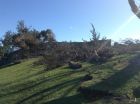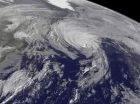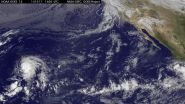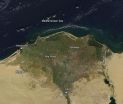(Press-News.org) Hurricane Gonzalo departed from Bermuda leaving power outages, downed trees, and damaged homes and buildings. An on-the ground account of the storm indicated the eye passed over the island. By Oct. 20, post-tropical storm Gonzalo was approaching the United Kindgom, sparking severe weather warnings.
By Sunday, Oct. 19 Gonzalo was affecting eastern Canada. Forecasters expect Gonzalo to hold together over while traveling east across the North Atlantic where it will affect Scotland as an extra-tropical storm on Tuesday, Oct. 21.
Camille Haley was former NASA intern and is now a resident of Bermuda. She provided an account of her experience as Hurricane Gonzalo struck the island on Oct. 17.
"Light rain and wind slowly strengthened during the mid-afternoon, as Gonzalo approached Bermuda," she said. "At around 4:00 p.m. local time the wind and rain intensified by the minute. On a typical day, we can see the ocean from the veranda but there was no visibility within 100 feet at this point. I saw an electric wire fall in the neighbors' backyard; it continued to spark for hours. Trees were bending, branches were snapping and leaves were blowing everywhere. We were surrounded in darkness as the electricity in the area had gone out. Candles, flashlights and occasional strikes of lightning were our only light source.
Suddenly there was a strange silence. The wind and rain had come to a complete stop. Curious, I opened the front door to feel a smothering heat. The sky was clear and all that could be heard was the whistling sound of what seemed like a million tree frogs. The eye of the storm had arrived. If I had not known that the eye of Hurricane Gonzalo was going to approach us, I could have assumed that the storm had passed. Thankfully during this time, we were able to get a phone call through to my Aunt who lives in Boston. She was able gave us an update on what was predicted to come next. Without warning the wind roared fiercely followed by harsh rain. The second half of Gonzalo arrived with ferocity. In my opinion this was the worst part. I barely slept fearing that the front door and windows were going to implode. The howling sound of the wind was haunting.
The next morning the sky was clear and the ocean was calm. Although my neighborhood didn't suffer much damage, other than a few electric wires falling, other areas of the island had fallen light poles, wires and trees, crushed fences and walls. Some homes had roofs that fell in or came completely off. I'm amazed at how many trees were uprooted or fallen over across the island."
By October 18, Gonzalo had moved north of Bermuda and was headed toward eastern Canada.
Between 7 a.m. and 8 a.m. on Oct. 19, a weather station on Cape Race, Newfoundland reported a sustained wind of 41 mph (67 kph) and a gust of 55 mph (89 kph). St. Johns Newfoundland recently reported a wind gust of 45 mph (72 kph).
At 8 a.m. EDT on Sunday, Oct. 19, Gonzalo was still a hurricane over the cold waters of the north Atlantic. A tropical storm watch is effect for Arnolds Cove to Chapels Cove, Newfoundland, Canada.
.On Sunday, Oct. 19 at 8 a.m. EDT, Gonzalo's center was near latitude 47.6 north and longitude 50.1 west. NOAA's GOES-East satellite captured a visible image of the storm on Sunday, Oct. 18 at 1145 UTC (7:45 a.m. EDT) that showed it in the North Atlantic, blanketing eastern Canada and stretching east over open waters. At that time, Gonzalo was moving toward the northeast near 52 mph (83 mph). Gonzalo moved quickly away from Newfoundland into the North Atlantic. Maximum sustained winds were near 85 mph (140 kph) and gradual weakening was forecast.
Just three hours later the MODIS instrument aboard NASA's Terra satellite captured a visible image that showed Hurricane Gonzalo had moved more than 150 miles further east from Newfoundland, Canada than when the GOES image was taken.
On Oct. 19 effects from Gonzalo were still being felt in many places because of dangerous ocean conditions. Large swells, now waning, were affecting the Virgin Islands, the northern coasts of Puerto Rico and the Dominican Republic, portions of the Bahamas, portions of the United States east coast, Bermuda and Atlantic Canada.
By Sunday night Gonzalo and become an extra-tropical cyclone with a cold core center (instead of a warm center like a tropical cyclone) as the National Hurricane Center expected.
Gonzalo is expected to affect Scotland on Tuesday, October 21 as an extra-tropical storm, packing heavy rains and gusty winds.
On Monday, Oct. 20, the U.K. Meteorological Service issued a National Severe Weather Warning for the U.K.: "The remains of Hurricane Gonzalo are running across the Atlantic, reaching the UK on Monday night, bringing a period of strong winds to the U.K. The strongest winds are expected on Tuesday as the low pressure clears eastwards; some uncertainty remains in peak windspeeds but there remains the potential for disruption to travel, especially as the strongest winds coincide with the morning rush hour in places. Fallen leaves impeding drainage increases the risk of surface water affecting roads, while some damage to trees is possible, given that many are still in full leaf." For updated warnings from the U.K. Met Service, visit: http://www.metoffice.gov.uk.
INFORMATION:
Rob Gutro
NASA's Goddard Space Flight Center
Tropical Storm Trudy formed on Saturday, Oct. 17 and by Oct.19 the storm made landfall in southern Mexico and weakened to a remnant low pressure area.
Tropical Storm Trudy formed near the southwestern coast of Mexico during the morning of Oct. 18 triggering warnings and watches. A Hurricane Watch was posted from east of Acapulco to Laguna De Chacahua Mexico and a Tropical Storm Warning was posted for Tecpan De Galeana to Laguna De Chacahua Mexico.
On Sat. Oct. 18 at 8 a.m. EDT, radar from Mexico indicated that the center of Tropical Storm Trudy was located on the coast ...
VIDEO:
This video shows the movement of Tropical Storm Ana near the Hawaiian Islands from Oct. 17-20.
Click here for more information.
Tropical Storm Ana made a slow track west of the Hawaiian islands over the last couple of days, and by Oct. 20 was moving westward away from the main Hawaiian islands and heading toward the northwest Hawaiian islands. NASA's Terra satellite caught Ana on a flyby on Oct. 19 that showed the storm's clouds blanketing the chain of islands.
The ...
This NASA satellite image is of the Egyptian River Delta. Actively burning areas, detected by MODIS's thermal bands, are outlined in red. Each hot spot, which appears as a red mark, is an area where the thermal detectors on the MODIS instrument recognized temperatures higher than background. When accompanied by plumes of smoke, as in this image, such hot spots are diagnostic for fire. The location, widespread nature, and number of fires in this image and confirmation from the Ministry of Environment in Egypt. Fires are witnessed every year in October and November, caused ...
Looking forward in science often requires looking back, evaluating trends to extrapolate future outcomes. A classic case is Moore's Law, which predicts that the density of components on an integrated circuit will double every 24 months. The estimate has helped guide many developments in the computer industry.
In a new study, Rolf Halden, PhD, a researcher at Arizona State University's Biodesign Institute, examines the trajectory of chemicals appearing as emergent threats to human or environmental health.
Halden's meta-analysis of 143,000 peer-reviewed research papers ...
About 20% of younger siblings of children with Autism Spectrum Disorder (ASD) will develop the condition by age 3. A new study by Yale School of Medicine researchers has found that 57% of these younger siblings who later develop the condition already showed symptoms at age 18 months.
Published in the October Journal of the American Academy of Child & Adolescent Psychiatry, this is the first large-scale, multi-site study aimed at identifying specific social-communicative behaviors that distinguish infants with ASD from their typically and atypically developing high-risk ...
ROSEMONT, Ill.—Obesity affects individual patient care, the healthcare system and nearly every organ in the body. People with obesity often have other health problems, including diabetes, heart disease, certain tumors and cancers, and psychiatric disorders. However, the role of obesity in orthopaedic conditions and their treatment is less well-publicized.
According to orthopaedic surgeon William M. Mihalko, MD, PhD, of Campbell Clinic Orthopaedics in Memphis, Tenn., "obesity can accompany a multitude of comorbidities that can have a significant impact on a patient's ...
Older individuals who are subliminally exposed to positive stereotypes about aging showed improved physical functioning that can last for several weeks, a new study led by the Yale School of Public Health has found.
Researchers used a novel intervention method to examine for the first time whether exposure to positive age stereotypes could weaken negative age stereotypes and their effects over time, and lead to healthier outcomes.
The study, to be published online in an upcoming issue of the journal Psychological Science, consisted of 100 older individuals (average ...
Antibiotics—one of modernity's great success stories—are charms that come with a curse. Their overuse in human and animal populations can lead to the development of resistant microbial strains, posing a dire threat to global health.
In a new study, Hansa Done, PhD candidate, and Rolf Halden, PhD, researchers at Arizona State University's Biodesign Institute, examine antibiotic use in the rapidly expanding world of global aquaculture.
Done and Halden measured the presence of antibiotics in shrimp, salmon, catfish, trout, tilapia and swai, originating from ...
This news release is available in German. Physical exercise in old age can improve brain perfusion as well as certain memory skills. This is the finding of Magdeburg neuroscientists who studied men and women aged between 60 and 77. In younger individuals regular training on a treadmill tended to improve cerebral blood flow and visual memory. However, trial participants who were older than 70 years of age tended to show no benefit of exercise. Thus, the study also indicates that the benefits of exercise may be limited by advancing age. Researchers of the German Center ...
ATLANTA (October 20, 2014) – New data presented today indicate that consumers of frozen meals (1) had higher daily intakes of dietary fiber, potassium, calcium and protein, and lower daily intakes of calories and saturated fat than consumers of quick service restaurant (QSR) meals (2). The poster, Consumption of Frozen Meals as Compared to Quick Service Restaurant Meals is Associated with Better Nutrient Intakes in Adult Participants of The National Health and Nutrition Examination Survey (2003-2010), was presented at the 2014 Academy of Nutrition and Dietetics Food ...







